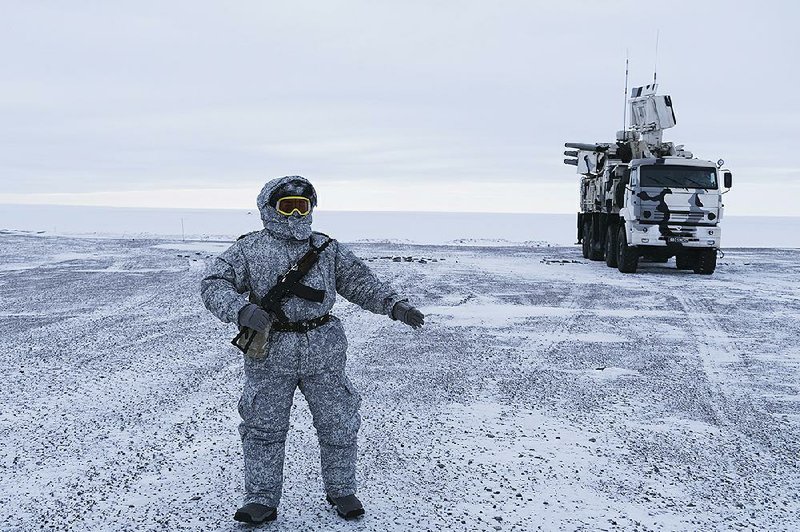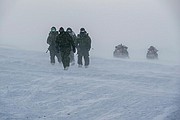RESOLUTE BAY, Canada -- After finishing a training drill on surviving the bitter cold, the soldiers gathered around Ranger Debbie Iqaluk to hear about an inescapable fact of life in the high Arctic: The ice is melting despite the low temperatures.
And that means the Russians are coming.
Her retelling of how she watched as an enormous iceberg fractured, just a few feet from the military base here, was riveting. It is one thing to be told constantly that the melting polar ice cap has opened up the Arctic, melting what used to be an impenetrable barrier between North America and Russia. It is quite another to see it firsthand.
The iceberg took five years to melt, and by 2018 it was gone, taken over by a sea that with each year is melting earlier in the season. That has taken Russia right to Canada's doorstep, cutting into the "Fortress North America" concept that has long comforted military planners on this side of the Atlantic Ocean.
NATO is rushing to try to catch up. Last month, hundreds of troops from member countries and partners, including France, Norway, Finland and Sweden, joined Canadian soldiers, reservists and rangers for the Nanook-Nunalivut exercises that aimed in part to help alliance forces match Russian readiness in extreme-cold climes. (The United States sent observers, but no troops this year.)
"Russia is increasing its military presence in the Arctic," said Dylan White, a spokesman for the North Atlantic Treaty Organization, citing the new Russian icebreaker fleet, weapons systems and radar.
The Western military alliance, he said, is "monitoring Russia's Arctic buildup carefully."
In fact, Russia has already claimed the North Pole, and in 2007 sent two mini-submarines to place a titanium Russian flag on the seabed, 2½ miles underwater. Twelve years later, during last month's alliance exercises, Canadian military officers were still grumbling about the stunt.
Ships now successfully ply the Northwest Passage in July -- something that was unheard of in 1845 when Sir John Franklin, a British explorer, tried to sail it, only to become icebound near King William Island. He lost his life and those of his 129-member crew.
Twenty percent of Russia's gross domestic product is pulled from the Arctic, whether in minerals or through its shipping lanes. It is far ahead of North America when it comes to maneuvering in the region; by comparison, less than 1 percent of the United States' economic output is derived from the Arctic.
Over the summer, a Maersk vessel loaded with Russian fish became the first container vessel to complete an Arctic sea route that Moscow is planning as part of an Arctic superhighway.
Moscow's military ambitions in the Arctic have also increased as Russia moves to defend the territory that it claims.
Last month, Russia's defense ministry flew a group of reporters to a military base on Kotelny Island, between the Laptev Sea and the East Siberian Sea on its new Arctic shipping route, to show off anti-ship missile launchers and air defense systems firing shots at a practice target.
Russia has also expanded its fleet of icebreaker ships to more than 40 (the United States has only two that are operational) and reopened military bases in the Arctic that were shut down after the end of the Cold War. Two months ago, a top Russian lawmaker told a state-run news agency that Russian special forces were training for a potential conflict in the Arctic.
At a meeting Tuesday of the International Arctic Forum, President Vladimir Putin of Russia outlined an ambitious program, including new ports and infrastructure, to further cement Russia's standing in the region. "We don't see a single matter that requires NATO's attention" in the Arctic, Foreign Minister Sergey Lavrov of Russia said at the same event.
In a telephone interview, Defense Minister Harjit Sajjan of Canada made clear that the alliance had no intention of ceding the icy expanse.
"We want Russia to know what our capabilities are," Sajjan said. "It prevents them from doing more aggressive things."
Resolute Bay is known as the "place with no dawn" by the Inuit people, who were forcibly relocated there in 1953 as part of a Canadian government plan to lay claim to land in the far north before Moscow could.
It is the second-most-northerly military base in North America; Canadian Forces Station Alert, just 500 miles from the North Pole, is first. Until Russia appeared on the horizon, "force protection" detail at Resolute Bay simply meant soldiers armed with ancient rifles standing guard against polar bears.
This year, it was ground zero for Operation Nanook-Nunalivut, the efforts to train troops how to survive in the high Arctic.
There are no northern lights despite the clear night, the troops are told, because, well, it is too far north. Trees cannot survive, either. The landscape is unrelentingly white -- white snow meeting white sky. The sea is white, the land is white.
"I thought I knew what winter was about," said Lt. Col. Aaron Williams, the commanding officer of the 1st Battalion of the Royal Canadian Regiment. "But then I arrived here and realized I don't know anything."
The most important thing that Williams said he tried to impress upon his troops was that of the two hostile forces in Arctic warfare, the one loaded with sophisticated weaponry was probably the lesser threat. The weather, he said, can dwarf everything: "You can't fight somewhere if you can't survive it."
The temperature that day was minus-22 degrees Fahrenheit. By comparison, it was almost toasty inside the igloos, made of blocks of hard-packed snow, where temperatures soared to just above freezing.
Early one morning, Iqaluk stood between the frozen sea and a group of soldiers heading out on snowmobiles on a practice mission to secure an airfield. Wearing a large pair of whitish gloves made from the fur of a polar bear, she served as a sort of Delphic oracle for whether the expeditioners had a chance of returning with their limbs intact.
"He needs to pull up that collar," she muttered, nodding at one soldier whose fleece-lined hoodie had dropped to expose the top of his wool hat.
SundayMonday on 04/21/2019


